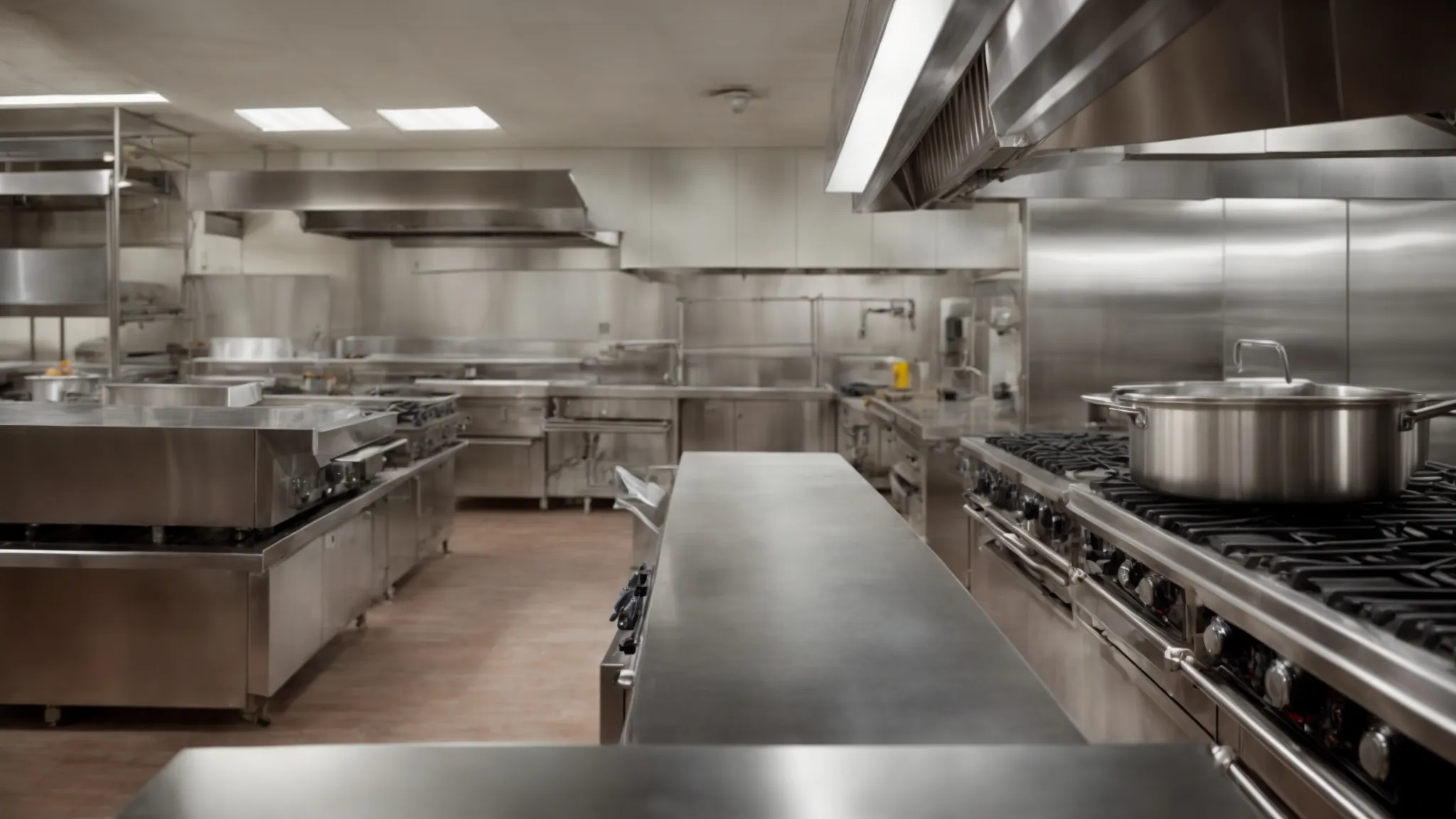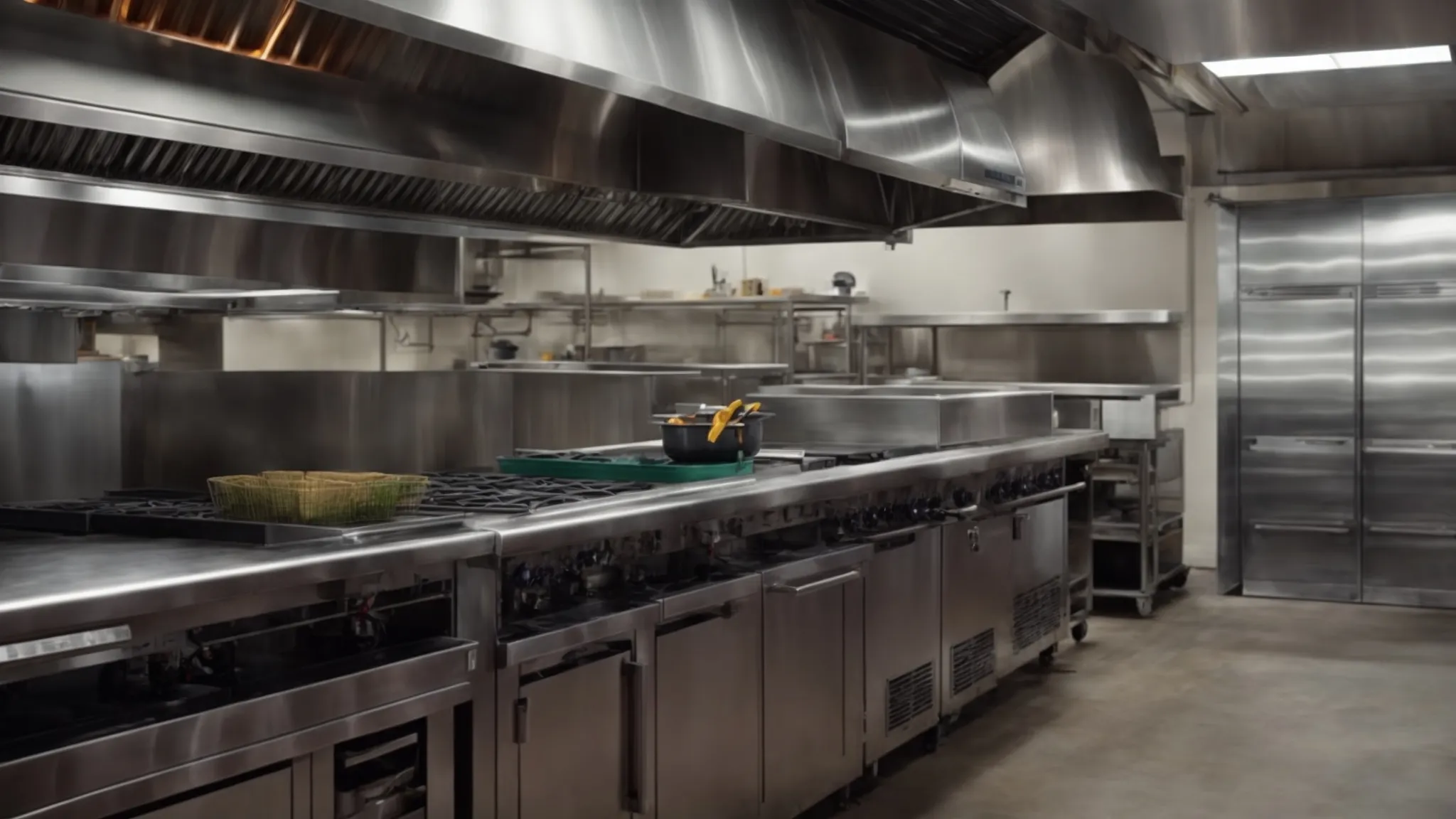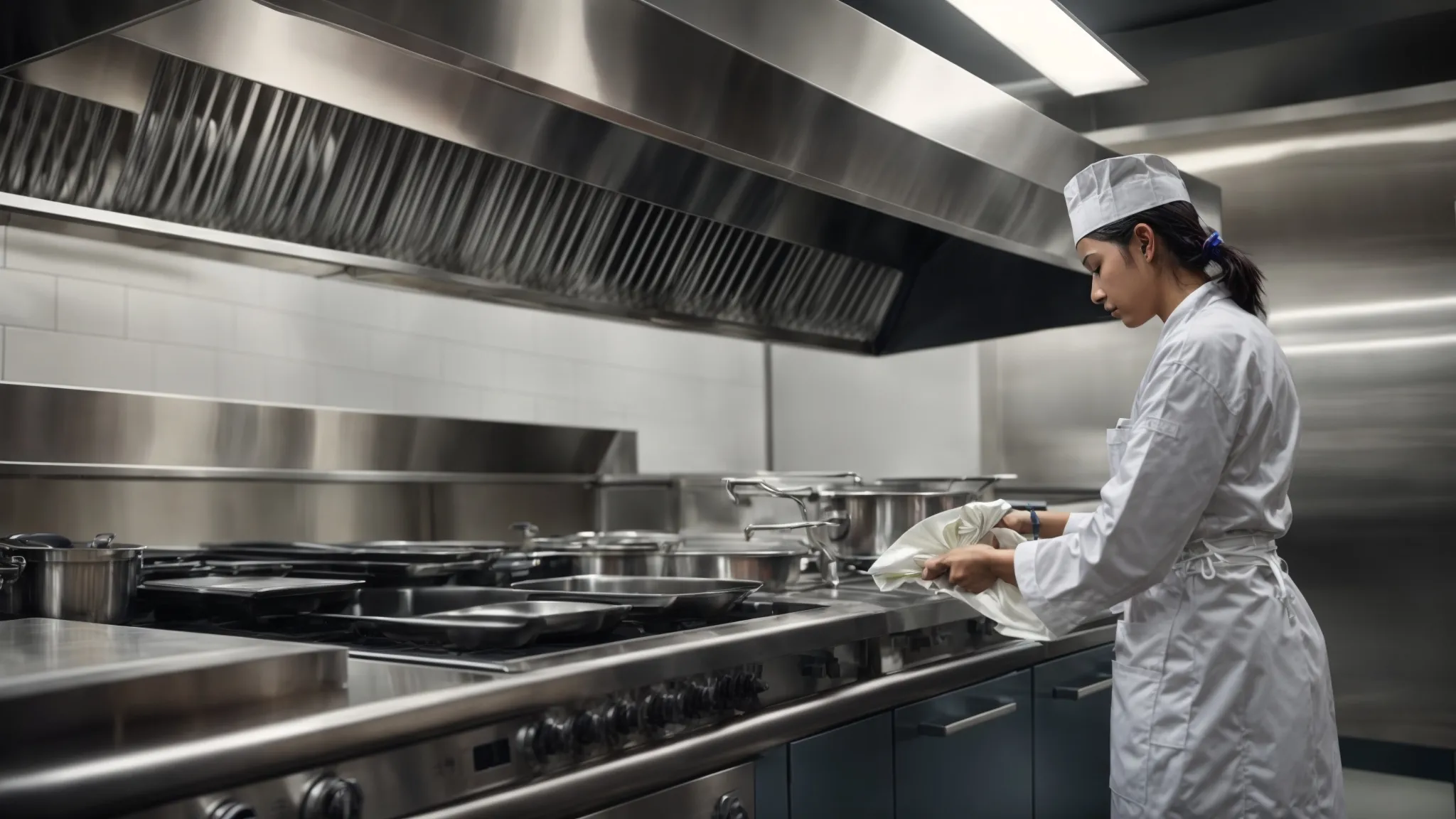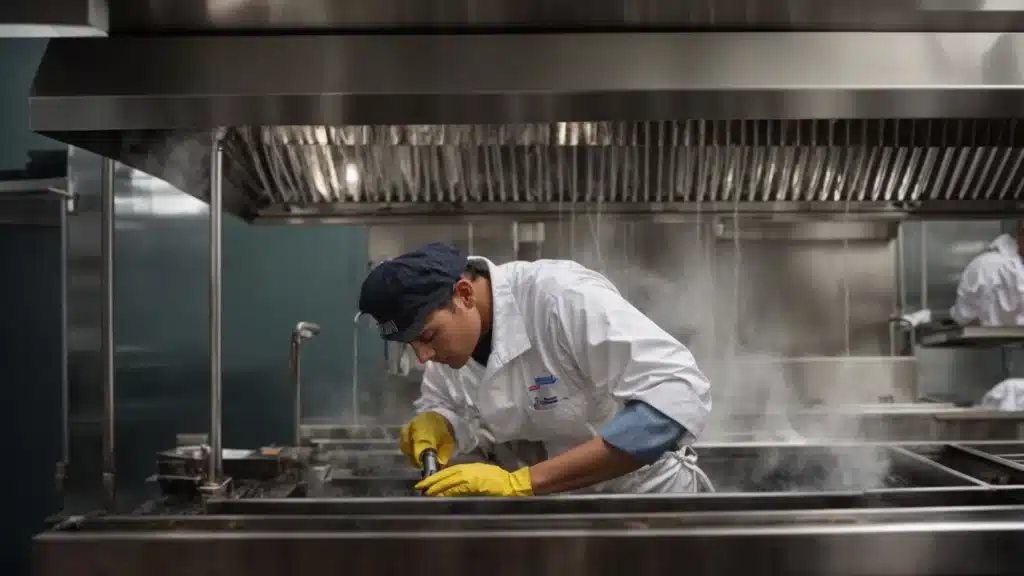Importance of Regular Hood and Kitchen Exhaust Cleaning
Regular Hood and Exhaust Cleaning: Key to Kitchen Hygiene
A bustling kitchen, alive with the symphony of sizzling pans and the chatter of diligent chefs, is the heart of any restaurant.
Yet, lurking in the shadows, the humble hood and exhaust system hold the key to not only the kitchen’s hygiene but its very soul.
Regular cleaning of these essential components ensures that the air stays as crisp as a fresh salad, free of grease, odors, and potential fire hazards, like a knight safeguarding his castle.
With the right guidance and tools, maintaining your kitchen’s lungs is simpler than one might think.
Keep reading to uncover the secrets to flawless kitchen ventilation, ensuring your culinary haven remains the jewel of your restaurant’s crown.
Key Takeaways
- Regular Hood and Exhaust Cleaning Is Essential for Maintaining a Healthy Cooking Environment
- Neglecting Hood and Exhaust Maintenance Poses Fire, Health, and Legal Risks
- Professional Cleaning Services Are Pivotal in Ensuring Kitchen Ventilation Systems Are Properly Maintained
- Choosing the Right Cleaning Agent, Whether Chemical or Natural, Matters in the Battle Against Grease and Odors
- Maintaining Cleanliness Between Professional Cleanings Extends the Life and Efficiency of Kitchen Ventilation Systems
Understanding the Importance of Hood and Exhaust Cleaning
In the heart of Ontario’s bustling culinary scenes, from the sparkling kitchens in Toronto to the vibrant dining spaces of Mississauga, lies an unseen defender of air quality and kitchen hygiene: the exhaust system.
Regular hood and exhaust cleaning transcends mere cleanliness, serving as the cornerstone of a healthy cooking environment.
Ignoring the build-up of grease, dust, and debris in these systems is akin to inviting a silent menace into the kitchen, one that threatens not just the cleanliness, but also the very air that chefs and patrons breathe.
Recognizing the crucial roles clean hoods and exhausts play not only identifies the hazards of neglect but also underscores their pivotal contribution to maintaining pristine air quality.
This unseen hero, when properly maintained, wields the power to vanquish odors, reduce air pollution, and herald a kitchen that is as fresh as the dishes it produces.
Identifying the Risks of Neglecting Kitchen Exhaust Systems
The neglect of regular hood and exhaust cleaning in commercial kitchens stokes the embers of risk, setting the stage for potential disasters. This oversight forms a tinderbox of hazards: from the increased risk of fire sparked by grease accumulation to the unseen danger of bacterial growth, the consequences of neglect are both dire and costly.
| Risk Factor | Consequence |
|---|---|
| Grease Accumulation | Heightened Fire Risk |
| Bacterial Growth | Health Hazards |
| Blocked Ventilation | Reduced Air Quality |
| Deteriorated Equipment Efficiency | Inflated Energy Costs |
Beyond the immediate dangers, the ripple effect of insufficient exhaust maintenance treads into the waters of legal jeopardy and insurance complications. Establishments that fail to adhere to rules set forth by the National Fire Protection Association (NFPA) face a treacherous path that includes steep fines, rising insurance costs, or, worse yet, the shuttering of doors to address violations.
The Role of Clean Hoods in Maintaining Air Quality
A breath of fresh air in any kitchen flows from more than just the aromatic wafts of cooking; it originates, significantly, from the diligent cleaning of hoods and exhaust systems. These fundamental components act as the lungs of the kitchen, inhaling the byproducts of culinary art—grease, smoke, and vapor – and exhaling a cleaner, safer atmosphere for both those who create and those who indulge.
In the orchestration of flavors and fragrances that mark Ontario’s diverse culinary ventures, a clean hood stands as an unsung hero, its role pivotal in maintaining the subtle balance between a bustling kitchen’s energy and the necessity for healthful, unadulterated air. This safeguarding of air quality is not just a tribute to sanitation but a commitment to the wellbeing of every individual who steps into the culinary arena, from chef to patron.
Now that we’ve explored the critical role hood and exhaust cleaning play in your culinary sanctuary, let’s roll up our sleeves. Engage in a journey through a meticulous step-by-step guide to rejuvenate your kitchen’s heart.
Step-by-Step Guide to Cleaning Your Kitchen Hood

Embarking on the journey of kitchen Hood Cleaning, a meticulous process unfolds, demanding not only dedication but the right arsenal of tools and safety equipment.
Before the first whisper of vapor or the faintest trace of grease can be addressed, the preparatory step stands as a guardian at the gate.
It’s a methodical dance of assembling brushes, degreasers, sponges, and protective gear, signifying readiness for a battle against grime.
The subsequent disassembly and cleaning of the hood delve deeper, stripping away layers of cooking’s byproduct to reveal the heart of a kitchen’s ventilation system.
This endeavor isn’t merely about scrubbing away the tangible; it’s about rejuvenating the very breath of the kitchen, ensuring a harmonious balance between fire and air, heat and coolness.
Thus, the ritual of cleaning transcends, embodying both the preservation of health standards and a tribute to the sacred space where culinary magic unfolds.
Preparing Your Tools and Safety Equipment
As the prelude to the symphony of sanitation that is kitchen hood cleaning, gathering your arsenal of tools and safety equipment stands as the critical first note. This stage goes beyond mere preparation; it’s about arming oneself for a task where precision meets safety, ensuring that every brush stroke and degreaser application is not only effective but protected against the unforeseen.
Compiling the necessary equipment is akin to laying the foundation for a fortress of hygiene: robust and impenetrable. From the sturdy bristles of a brush designed to dislodge stubborn grease to the gentle caress of sponges that wipe away residue without leaving scars, each tool plays its designated role. Likewise, safety glasses, gloves, and aprons form the armor against splashes and spills, shielding the cleaner from potential harm:
| Tool/Equipment | Function | Safety Feature |
|---|---|---|
| Brush | Dislodge Grease | N/A |
| Sponge | Wipe away residue | Gentle on surfaces |
| Protective Gloves | Hand protection | Shields against chemicals and heat |
| Safety Glasses | Eye protection | Prevents splashes from entering eyes |
| Apron | Body protection | Guards clothing and skin from spills |
Detailed Process for Dismantling and Cleaning the Hood
The journey to a pristine kitchen starts with the careful dismantling of the hood: an intricate ballet of unscrewing panels and sliding-out filters, performed with the precision of a skilled craftsman. Each component, from the bustling hum of the exhaust fan to the silent guard of the grease trap, is methodically separated and prepared for its renewal:
- Gently remove the grease filters and dip them into a warm, soapy solution to soak.
- Utilize a specialized brush and degreaser to meticulously clean the interior surfaces of the hood, paying close attention to areas with significant buildup.
- Proceed to disassemble the fan and ductwork, applying the same diligent process of degreasing and scrubbing.
- Rinse all components with a stream of clear water, ensuring that no residue of soap or degreaser remains.
- Dry each piece thoroughly with a microfiber towel before reassembling the hood and its components.
With each step, the once grimy and overlooked corners of the kitchen breathe anew, embracing the heat of the stove and the sizzle of the pan with renewed vigor. The reassembled hood, crowned with sparkling filters and a gleaming exterior, stands as a testament to the meticulous effort poured into its revival.
Mastering the art of kitchen hood cleaning sets the stage for the next crucial act. Let’s gear up to handpick the champions in the battle against grease!
Choosing the Right Cleaning Supplies for Grease Removal

In the labyrinth of commercial kitchen hygiene, the quest for the golden fleece of cleanliness often leads to a crossroads: the choice between chemical cleaners and natural solutions for grease removal.
This pivotal decision is not just about banishing the spectre of grime but also choosing allies in the battle against the odorous stench and stubborn residues that plague hoods and exhausts.
As keepers of culinary sanctity deliberate on their arsenal, understanding the merits and drawbacks of each cleaner type becomes as crucial as the selection of essential tools that guarantee an exhaustive purge of contaminants.
Herein lies the foundation for a kitchen environment that not only glimmers with cleanliness but also ensures the health and safety of its culinary artisans and their guests.
Comparing Chemical Cleaners vs. Natural Solutions
In the realm of kitchen exhaust and hood cleaning, selecting the appropriate cleaning agent is akin to choosing the right weapon for battle: each has its unique strengths and applications. Chemical cleaners, revered for their potent degreasing capabilities, cut through layers of grease and grime with the precision of a skilled swordsman, ensuring a level of cleanliness that is both visible and microscopic.
Natural solutions, on the other hand, whisper tales of eco-friendly battles fought with vinegar, baking soda, and lemon. These gentle warriors offer a safe passage to cleanliness, reducing the environmental impact while maintaining a formidable stance against the oily adversaries that lurk within kitchen hoods and exhausts:
- Vinegar acts as a versatile ally, dismantling grease with its acidic prowess.
- Baking soda, with its mild abrasive texture, polishes surfaces while absorbing odors.
- Lemon, the citrus sentinel, harnesses the power of scent and acidity to cut through grease spots.
Essential Tools for an Effective Exhaust Cleanup
In the diligent quest to achieve a pristine kitchen exhaust system, the selection of essential tools emerges as a beacon of efficiency. Among these, a high-pressure washer stands tall: its robust jets are capable of disintegrating even the most obstinate grease, rendering the exhaust ducts as clean as Ontario’s crystalline lakes.
Following closely in this curated arsenal is the dynamic duo of metal scrapers and industrial-grade degreasers. These tools, when wielded with expertise, slice through layers of accumulated grease and grime, ensuring that no corner of the exhaust system harbors the shadows of contamination:
- High-pressure washer for blasting away grease.
- Metal scrapers to physically remove stubborn buildup.
- Industrial-grade degreasers for dissolving residual grease and ensuring a thorough cleaning.
Armed with the finest degreasing armory, the battle against kitchen grime takes a pivotal turn. Next up, let’s chart the course for ensuring a fire-free future through diligent maintenance schedules.
Scheduling Regular Maintenance to Prevent Fire Hazards

Maintaining the cohesion between fire safety and kitchen hygiene demands a vigilant approach to scheduling regular hood and exhaust cleanings.
Aware of the lurking dangers that grease and debris present, establishing a routine that aligns with the operational demands and safety requirements of a commercial kitchen becomes imperative.
It’s not merely about reacting to visible signs of buildup but preempting potential hazards through a tailored schedule, ensuring the heart of the culinary operation beats without the shadow of risk.
Delving into the frequency of cleanings and devising a customized plan forms the cornerstone of this preventive strategy, safeguarding against fire hazards while upholding the standards of kitchen cleanliness.
How Often Should You Clean Your Kitchen Exhaust?
The frequency of kitchen exhaust cleaning hinges on the volume of cooking and the type of food prepared within the commercial kitchen’s bustling confines. For high-volume establishments like popular restaurants or banquet halls, experts recommend a quarterly cleanse to prevent grease accumulation and mitigate fire risks.
Conversely, kitchens with lighter cooking schedules, such as those in schools or cafes, might only necessitate a semi-annual inspection and cleaning. This adaptive scheduling ensures that every kitchen maintains optimal hygiene and safety standards, tailored to their specific operational tempo.
Setting Up a Cleaning Schedule That Works for You
Forging a cleaning schedule tailored to a kitchen’s unique dynamics is akin to crafting a bespoke suit; precision and customization are paramount. Understanding the rhythm of your kitchen’s operations and the types of dishes prepared allows for a schedule that meshes seamlessly with your culinary activities, ensuring cleanliness without interrupting the flow of creativity and service.
Engage with professional cleaning services that understand the nuances of your kitchen’s needs and can offer flexible scheduling options. This collaboration enables the establishment of a maintenance routine that not only adheres to safety standards but also respects the unique demands of your culinary enterprise, ensuring a harmonious balance between hygiene, safety, and productivity.
The leap from routine maintenance to tackling the beast of cleanliness in commercial kitchens is a bold one. Let’s venture into the world of professional versus DIY hood and exhaust cleaning, distinguishing the heroes from the handymen.
Professional Versus DIY Hood and Exhaust Cleaning

In the bustling heart of a commercial kitchen, where the sizzle of a pan meets the clamor of a busy service, the choice between a professional or do-it-yourself approach to hood and exhaust cleaning becomes a pivotal decision.
This segment delves into the nuances of knowing the right moment to enlist the expertise of professional cleaners for a deep dive into kitchen hygiene.
It also offers sage advice on keeping your system in peak condition between those thorough cleanings, ensuring a seamless blend of self-maintenance and expert intervention.
Recognizing the fine line between these options equips kitchen operators with the knowledge to maintain an impeccable environment, balancing day-to-day upkeep with the necessity for professional oversight.
When to Call in Professionals for a Deep Clean
In the realm of kitchen maintenance, the inflection point where professional intervention becomes imperative is not always marked by glaring signs. It is often the subtle accumulation of grease and the insidious spread of odors that herald the need for professional exhaust cleaning services: a call to action for the restoration of hygiene and efficiency within the bustling precincts of a commercial kitchen.
| Sign | Indications for Professional Clean |
|---|---|
| Visible Grease Buildup | Indicates potential fire hazards and health risks |
| Persistent Odors | This signifies inadequate air quality and possible bacteria growth |
| Deterioration in Ventilation Efficiency | Highlights compromised airflow and energy inefficiency |
Engaging professional cleaners becomes particularly crucial ahead of routine inspections or in the wake of an unexpected kitchen incident, such as a small fire or smoke problem: these events act as harbingers, underscoring the potential perils of postponed or subpar cleaning routines. Proactive enlistment of expert hood and exhaust cleaning services not only preemptively tackles the roots of these hazards but also instills a sense of confidence and assurance in the operational standards of the kitchen.
Tips for Maintaining Your System Between Professional Visits
In the interim between professional cleanings, a vigilant eye coupled with simple, consistent actions can significantly extend the life and efficiency of a kitchen’s hood and exhaust system. Regularly inspecting the hood for grease accumulation and wiping away any visible residue with a warm, soapy water solution helps prevent the build-up that serves as fodder for potential hazards.
Moreover, encouraging a culture of cleanliness among kitchen staff, where every member takes responsibility for minimizing splatter and diligently using screens and guards during high-grease cooking activities, can drastically reduce the frequency and intensity of necessary deep cleans. This shared dedication to hygiene acts as a proactive barrier, safeguarding the kitchen against the encroachment of grime and ensuring operational excellence.
Leaving the world of DIY hood cleaning behind, we embrace the sparkling realm of professional upkeep. Uncover the myriad benefits awaiting in the next chapter of our kitchen’s ventilation journey.
Benefits of Keeping Your Kitchen’s Ventilation System Clean

Maintaining a clean kitchen ventilation system through regular hood and exhaust cleaning goes beyond the mere elimination of visible grime; it emerges as a vital player in the larger arena of kitchen hygiene, significantly impacting health inspection scores.
This process, often underestimated, serves as a testament to the establishment’s commitment to health standards, influencing the overall perception and ensuring a favorable review from health inspectors.
By safeguarding against the accumulation of grease, dust, and other contaminants, businesses not only demonstrate adherence to strict hygiene protocols but also proactively champion the well-being of both staff and patrons.
As such, the benefits of a meticulously maintained ventilation system echo throughout the culinary domain, reinforcing the essence of cleanliness in every aspect of operation.
The Impact on Health Inspection Scores
A kitchen’s adherence to cleanliness, specifically through regular hood and exhaust cleaning, shines brightly under the scrutiny of health inspectors, often being a decisive factor in achieving favorable scores. This meticulous attention to ventilation hygiene serves not only as a testament to the establishment’s commitment to health standards but also significantly mitigates the risk of violations that could mar its reputation.
Enhanced health inspection scores, resulting from diligent exhaust and hood maintenance, bolster an establishment’s standing in the culinary community, reflecting a dedication to safety and hygiene. In turn, these scores can inspire greater confidence among patrons, fostering a trust that extends beyond the allure of the menu to the heart of kitchen operations—a trust in the establishment’s unyielding commitment to health and well-being.

